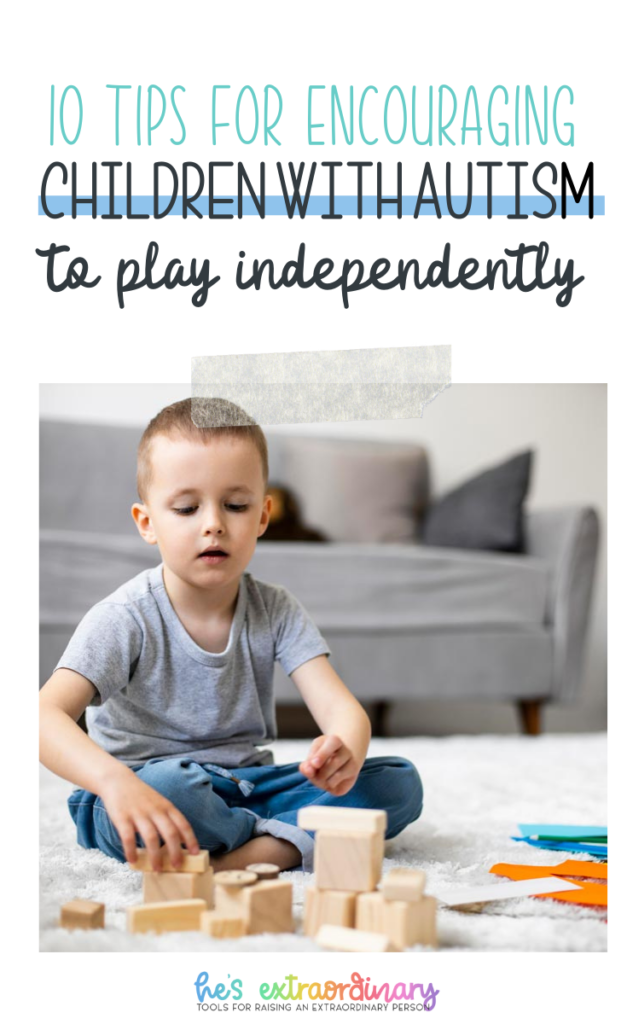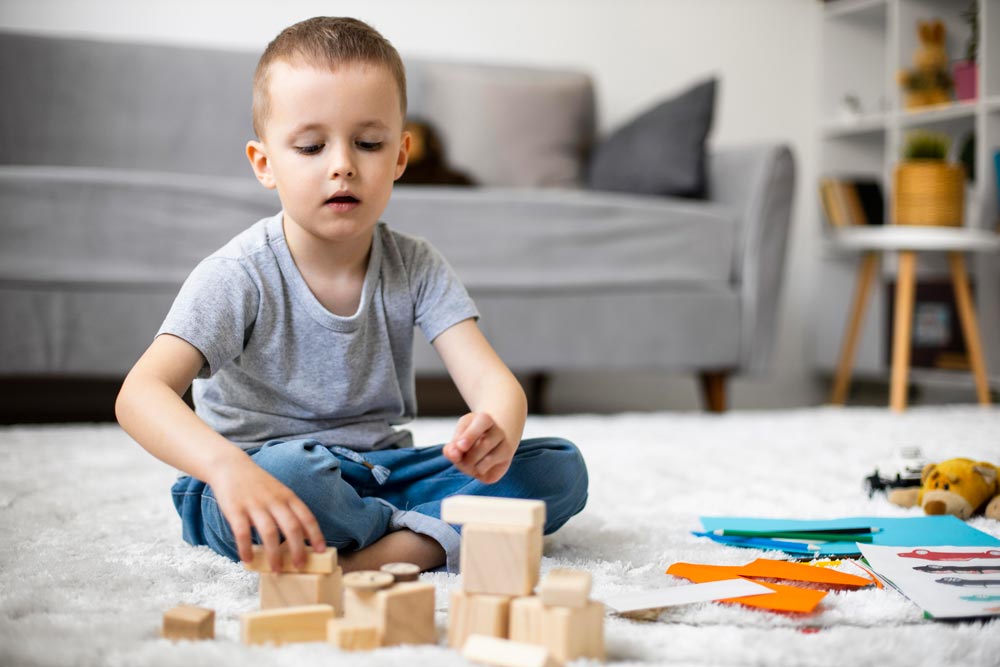10 Tips for Encouraging Autistic Children to Play Independently
What’s inside this article: 10 tips for parents or educators for encouraging children with autism to play independently, and how that independent play benefits social-emotional development.
If you’re a parent, or a teacher, of a child with autism, one of your goals may be to encourage them to play more independently, without direct guidance from yourself or another adult.
Telling your child “go play!” is probably too vague for them. But, children learn best through play. And different types of play helps with the development of different skills.
Through play, children can explore, discover, find meaning, problem solve, and take risks. These are all critical aspects of learning and strengthening social skills.
Playing with others helps children learn social cues, listening, perspective taking, turn-taking, sportsmanship, and how to share ideas with others and negotiate if necessary.
With guidance, playing also helps kids learn self-regulation. As kids play, they experience emotions like frustration and anticipation. With the support of an adult, this is an excellent opportunity to practice expressing and coping with these feelings safely and appropriately.
Many autistic children struggle during unstructured time; independent play is an opportunity to practice and learn their expectations during unstructured time.
Play Skills
There are different categories of play, and children’s play skills should progress through a set of milestones for each category.
Familiarizing yourself with those milestones and knowing your child’s current skills is essential because children with autism often show uneven development across different categories.
You need to make sure the expectations you’re setting for your child are realistic, so independent play should only involve play skills they’ve already mastered.
Read all of the milestones of play here.
Benefits of Independent Play
Builds confidence:
Letting your child tackle manageable challenges and trying to overcome obstacles on their own helps their confidence grow. They learn to believe in themselves and their abilities and feel a sense of accomplishment from doing things on their own. Research shows that children who can play independently develop a sense of confidence in their abilities and are more independent in other areas of their daily life
Supports learning:
In childhood, play is the basis of almost all learning. Research shows that play-based learning is more effective than other teaching methods, such as direct instruction. For children with autism, play is an opportunity to practice new skills in different environments, which is key to generalizing new abilities.
Inspires creativity:
Imaginative play is fundamental to children’s social-emotional learning, playing a role in many social skills. Imaginative play doesn’t always come as naturally to autistic children as it does to their neurotypical peers, but you can set them up for success by planning independent play activities where they can try need things in a comfortable environment.
Reduces stress:
Children need quiet time, especially children prone to overstimulation, which can lead to meltdowns. Quiet, independent play activities help reduce stress because they are low demand and not overstimulating.
How to Encourage Children with Autism to Play Independantly

1. Follow a daily routine:
Children thrive on consistency and structure. Unstructured time is often when challenging behaviors occur. Make independent play a part of your daily routine. You can structure their playtime best by doing it at the same time every day, playing in the same room/area every time, using a visual schedule, and providing consistent transitions between activities. Read more tips for increasing structure at home here.
2. Progress gradually:
Introduce solo play a little at a time. In the beginning, this may be challenging for your child because it’s new and because expectations may not seem clear to them.
You may want to start with just a 5 or 10 minute period in the beginning and gradually increase the time spent playing alone. Using a visual timer is helpful to show your child how long you expect them to play.
3. Remain accessible:
If your child’s used to having you by their side throughout every activity, they may get anxious during independent play. Stay close by, check in on them regularly, and be available to help, give guidance, and redirection – especially as your child learns what to expect.
4. Minimize directions:
Because children with autism often struggle with ambiguity, you might be tempted to tell or show them exactly what to do. Instead, try setting up some play materials and then let your child take the lead.
For example, you may provide them some play-doh with tools and cutters but let them make whatever they want. Or, you could set up their toys in their play area for a tea party before leaving them to play solo.
5. Design a safe play area:
Make sure your child’s independent play area is safe for them to explore freely. Childproof the area and make it inviting and comfortable for them.
6. Provide appropriate toys:
To avoid frustration, pick games and toys that are suited to your child’s age and abilities. Refer back to the play skill milestones here if needed when planning solo playtime for your child.
Building themed bins, based on interests and skills help ensure their play activities are appropriate. Plus, building materials like legos, magnetic blocks, play-doh, and popsicle sticks encourage creativity while also helping with fine-motor development.
7. Avoid overstimulation:
Sensory overload occurs when the brain receives more information from the senses (sight, smell, taste, touch, and sound) than it can process and interpret at one time. This causes stress and meltdowns.
Don’t overload the play area with too many toys or visuals, bright lights, etc. Instead, rotate toys, so your child has just a couple of things to choose from each day, and keep their space quiet and calming.
8. Offer rewards:
Give your child credit for playing independently. There are many ways to do this, depending on what motivates your child. Verbal praise, sticker charts, small treats, or time together doing a special activity are great options.
9. Maximize quality time:
It may also help to pay extra attention to your child before you leave them on their own, especially if they tend to engage in attention-seeking behavior the second you turn your back.
You will never eliminate your child’s need for attention – your attention is one of your child’s basic needs and critical to their development. So give them lots of it before setting the expectation to play alone.
10. Be flexible:
There will be times when you need to adapt your expectations to meet your child’s current needs. Most children go through stages when they need more attention and comfort temporarily.
This can happen after big or small changes in their day-to-day life, a stressful event, when they aren’t feeling well, or after a night of poor sleep.
Playing independently can be challenging for autistic children because they often have social and communication challenges that make it more difficult to play creatively.
However, you can help build these skills with appropriate planning, benefiting your child’s social and emotional development. If you are stukk struggling to find activities that allow your child to play creatively and independently, consider seeking input from their therapist.

